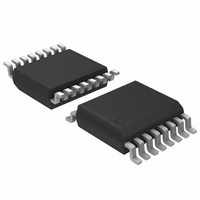ADT7483AARQZ-REEL ON Semiconductor, ADT7483AARQZ-REEL Datasheet - Page 23

ADT7483AARQZ-REEL
Manufacturer Part Number
ADT7483AARQZ-REEL
Description
IC TEMP SENSOR/ALARM 3CH 16-QSOP
Manufacturer
ON Semiconductor
Datasheet
1.ADT7483AARQZ.pdf
(24 pages)
Specifications of ADT7483AARQZ-REEL
Function
Temp Monitoring System (Sensor)
Topology
ADC, Comparator, Multiplexer, Register Bank
Sensor Type
External & Internal
Sensing Temperature
-40°C ~ 125°C, External Sensor
Output Type
SMBus™
Output Alarm
Yes
Output Fan
Yes
Voltage - Supply
3 V ~ 3.6 V
Operating Temperature
-40°C ~ 125°C
Mounting Type
Surface Mount
Package / Case
16-QSOP
Lead Free Status / RoHS Status
Lead free / RoHS Compliant
LAYOUT CONSIDERATIONS
Digital boards can be electrically noisy environments, and the
ADT7483A measures very small voltages from the remote
sensor, so care must be taken to minimize noise induced at the
sensor inputs. Follow these precautions:
•
•
•
Place the ADT7483A as close as possible to the remote
sensing diode. Provided that the worst noise sources such
as clock generators, data/address buses, and CRTs are
avoided, this distance can be 4 inches to 8 inches.
Route the D+ and D– tracks close together, in parallel,
with grounded guard tracks on each side. To minimize
inductance and reduce noise pickup, a 5 mil track width
and spacing is recommended. Provide a ground plane
under the tracks, if possible.
Minimize the number of copper/solder joints that can cause
thermocouple effects. Where copper/solder joints are used,
make sure that they are in both the D+ and D− path and at
the same temperature.
Thermocouple effects should not be a major problem as
1°C corresponds to approximately 200 mV, and thermo-
couple voltages are about 3 mV/°C of temperature difference.
Unless there are two thermocouples with a large temperature
differential between them, thermocouple voltages should
be much less than 200 mV.
GND
GND
D+
D–
Figure 22. Typical Arrangement of Signal Tracks
CPU THERMAL
2N3904/06
DIODE
OR
5MIL
5MIL
5MIL
5MIL
5MIL
5MIL
5MIL
D1+
D1–
D2+
D2–
ADD0
ADD1
ADT7483A
Rev. 1 | Page 23 of 24 | www.onsemi.com
Figure 23. Typical Application Circuit
GND
THERM
SDATA
ALERT
SCLK
V
DD
0.1μF
FAN ENABLE
V
DD
TYP 10kΩ
•
•
•
Because the measurement technique uses switched current
sources, excessive cable or filter capacitance can affect the
measurement. When using long cables, the filter capacitance
can be reduced or removed.
APPLICATION CIRCUIT
Figure 23 shows a typical application circuit for the ADT7483A,
using discrete sensor transistors. The pull-ups on SCLK,
SDATA, and ALERT are required only if they are not already
provided elsewhere in the system.
The SCLK and SDATA pins of the ADT7483A can be interfaced
directly to the SMBus of an I/O controller, such as the Intel® 820
chipset.
Place a 0.1 μF bypass capacitor close to the V
extremely noisy environments, place an input filter
capacitor across D+ and D− close to the ADT7483A. This
capacitance can effect the temperature measurement, so
care must be taken to ensure that any capacitance seen at
D+ and D− is a maximum of 1,000 pF. This maximum
value includes the filter capacitance, plus any cable or stray
capacitance between the pins and the sensor diode.
If the distance to the remote sensor is more than 8 inches,
the use of twisted pair cable is recommended. A total of
6 feet to 12 feet is needed.
For very long distances (up to 100 feet), use shielded
twisted pair, such as Belden No. 8451 microphone cable.
Connect the twisted pair to D+ and D−, and the shield to
GND close to the ADT7483A. Leave the remote end of the
shield unconnected to avoid ground loops.
TYP 10kΩ
FAN CONTROL
3V TO 3.6V
CONTROLLER
CIRCUIT
SMBUS
5V OR 12V
ADT7483A
DD
pin. In




